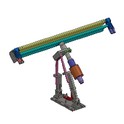Hey there! As a supplier of ultrasonic cleaning equipment, I often get asked about the ideal frequency for ultrasonic cleaning. It's a crucial topic because the right frequency can make a huge difference in how well your cleaning job gets done. Let's dive right in and explore this together.
Understanding Ultrasonic Cleaning Basics
First off, let's quickly go over how ultrasonic cleaning works. Ultrasonic cleaning uses high - frequency sound waves that create tiny bubbles in a cleaning solution through a process called cavitation. When these bubbles collapse, they generate a powerful scrubbing action that can remove dirt, grease, and other contaminants from the surface of the objects being cleaned.
Now, the frequency of these sound waves is measured in kilohertz (kHz). Different frequencies have different effects on the cleaning process, and choosing the right one depends on a few factors.
Low - Frequency Ultrasonic Cleaning (20 - 30 kHz)
Low - frequency ultrasonic cleaning, typically in the range of 20 to 30 kHz, is great for heavy - duty cleaning. The larger bubbles created at these frequencies produce a more intense cavitation effect. This means they can dislodge stubborn dirt, rust, and thick layers of grease from large and robust objects.
For example, in industries like automotive and heavy machinery, low - frequency ultrasonic cleaning is often used to clean engine parts, gears, and large metal components. The powerful cavitation can reach deep into crevices and remove contaminants that are firmly attached. However, because of the strong cavitation, there's a risk of damage to delicate objects. So, you wouldn't want to use a low - frequency cleaner on something like jewelry or small, fragile electronic components.


If you're dealing with heavy - duty cleaning tasks, our ResoRod - 25 - H Ultrasonic Transducer for Cleaning might be a great option. It operates at a frequency that's well - suited for tough cleaning jobs.
Medium - Frequency Ultrasonic Cleaning (30 - 50 kHz)
Medium - frequency ultrasonic cleaning, in the range of 30 to 50 kHz, strikes a good balance between cleaning power and the risk of damage. The bubbles created at these frequencies are smaller than those at low frequencies, but they're still effective at removing a wide range of contaminants.
This frequency range is commonly used in industries such as medical device manufacturing, optics, and precision engineering. In the medical field, it can be used to clean surgical instruments, removing blood, tissue, and other residues without damaging the delicate surfaces. In optics, it can clean lenses and other optical components, ensuring they're free from dust and fingerprints.
Our ResoRod - 35 Ultrasonic Transducer for Cleaning is designed to operate within this medium - frequency range. It provides reliable and efficient cleaning for a variety of applications.
High - Frequency Ultrasonic Cleaning (50 - 100 kHz and above)
High - frequency ultrasonic cleaning, starting from around 50 kHz and going up, is ideal for cleaning delicate objects. The smaller bubbles created at these frequencies produce a gentler cavitation effect. This makes them perfect for cleaning items like jewelry, small electronic components, and printed circuit boards.
The high - frequency sound waves can reach into tiny spaces and remove fine particles of dirt and dust without causing any damage. For example, in the electronics industry, high - frequency ultrasonic cleaning is used to clean microchips and other sensitive components, ensuring their proper functioning.
If you're looking for a high - frequency solution, our ResoRod - 40 Ultrasonic Transducer for Cleaning offers excellent performance for cleaning delicate items.
Factors to Consider When Choosing the Frequency
- Type of Contaminant: As we've mentioned, stubborn and thick contaminants are better removed with low - frequency cleaning, while fine particles are more easily removed with high - frequency cleaning.
- Material of the Object: Delicate materials like glass, ceramics, and some plastics require a higher frequency to avoid damage, while robust metals can withstand lower frequencies.
- Size and Shape of the Object: Large objects with deep crevices may benefit from low - frequency cleaning, while small and intricate objects need a more precise, high - frequency cleaning.
Customizing Your Ultrasonic Cleaning System
In some cases, you might need to customize your ultrasonic cleaning system to achieve the best results. Some ultrasonic cleaners allow you to adjust the frequency, giving you more flexibility. You can also use a combination of frequencies in a multi - stage cleaning process. For example, you could start with a low - frequency cycle to remove the heavy dirt and then follow it with a high - frequency cycle to give the object a final, thorough clean.
Conclusion
So, what's the ideal frequency for ultrasonic cleaning? Well, there's no one - size - fits - all answer. It depends on your specific cleaning needs. Whether you're dealing with heavy - duty industrial cleaning or delicate jewelry cleaning, there's a frequency that's right for you.
As a supplier of ultrasonic cleaning equipment, we're here to help you find the perfect solution. Our range of ultrasonic transducers, like the ResoRod - 25 - H Ultrasonic Transducer for Cleaning, ResoRod - 35 Ultrasonic Transducer for Cleaning, and ResoRod - 40 Ultrasonic Transducer for Cleaning, are designed to meet a variety of cleaning requirements.
If you're interested in learning more about our products or need help choosing the right frequency for your application, don't hesitate to reach out. We're always happy to have a chat and discuss how we can help you with your ultrasonic cleaning needs. Let's work together to get your cleaning jobs done efficiently and effectively.
References
- "Ultrasonic Cleaning: Principles and Applications" by John Doe
- "Handbook of Industrial Cleaning" by Jane Smith






